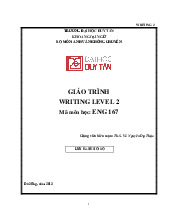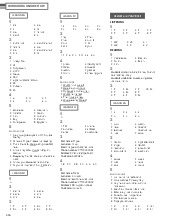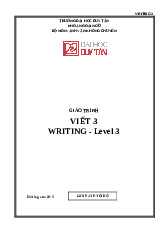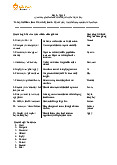











Preview text:
1. Due to the importance of quality service, manager should:
A. Know excellent service is key success
B. Hire more front line employees C. Communicate with customers
D. Decide which services can be offered
2. All of these are recovery strategies for service, except: A. Apology B. Invitation C. Empathy D. Compensation
3. The internal service is for employees of which staff category? A. Primary service employees B. Service support employees C. The two above
D. Affiliated service employees
4. The challenges of technology in the hospitality workplace can be understood as: A. Difficult to call B. Inconvenient to meet
C. IM may not be an accurate perception D. All of the above
5. The importance of quality service is in long-term it costs …. times more money to attract new buyers: A. 5-6 B. 4-5 C. 3-4 D. 6-7
6. All of these are not a consequence of service failure, except: A. Distraction B. Dissatisfaction C. Discrimination D. Dissemination
7. Which is the manifestation of contact overload syndrome? A. Fatigue B. Detachment and do as robot C. The two above D. Feel guilty
8. The prevalence of technology in the hospitality industry can be counted as:
A. Computer-mediated communication B. IM C. Shopping online D. All of the above
9. Defining the target customer will help: A. Meet various needs B. Offer different promotions C. Call for feedback D. Set new goal
10. All of the below are methods for assessing service quality, except: A. Accurately measure
B. Based on quantity of customer
C. Observe process and evaluate outcome
D. Based on customer’s level of satisfaction
11. What is the psychological need of customer’s perspective? A. Identity B. Security C. The two above D. Creativity
12. The principle of customer service and the telephone is: A. Answer by second ring B. Listen carefully C. Keep promises D. All of the above
13. One unique nature of service is production and consumption occurs: A. Simultaneously B. Feasibly C. Possibly D. Alternatively
14. For the perspective of service provider, manager should refer to feedback of customer and: A. Association B. Correction C. Promotion D. Compensation
15. Which is the tip for great customer service? A. Trigger emotions B. “No” is a swear word C. The two above D. Be at the right place
16. Which of the following job positions is categorized as secondary service employee in a hotel? A. Receptionist B. Restaurant server C. Housekeeper D. Laundry staff
17. The vocal variety in the effective speaking consists of: A. Tone, stress, accuracy B. Accent, pattern, words
C. Inflection, rate, volume D. Fluency, knowledge, timely
18. One importance of effective listening is that it: A. Make speaker talks clearer
B. Proves listener has more knowledge C. Decreases conflict D. Builds relationships
19. The paralanguage in the effectively speaking is the: A. Way to express feelings B. Way to convince people C. Way to say words D. Way to explain a story
20. The effective listening can help employees to accomplish tasks with: A. No problem
B. The help from other employees C. Less conflict
D. Fewer misunderstandings
21. Feedback is a …. that sender receives from partner of communication: A. Response B. Message C. Reflection D. Statement
22. The fluency in communication refers to the:
A. Accurate speaking with using filters
B. Accurate pronunciation without using filters
C. Accurate speaking without using filters
D. Accurate pronunciation with using filters
23. One factor that influences the listening is: A. Problem B. Position C. Power D. Personal traits
24. In speaking, a pause can draw what from listener? A. Curiosity B. Thinking C. Attention D. Question
25. In the Brownell’s HURIER listening model, the 2nd R is: A. Remembering B. Reacting C. Repeating D. Responding
26. Which of these is a mode of verbal communication? A. Mediated communication B. Body language C. Actions D. Visual symbols
27. The communication that is informal, as a social interaction, and disseminates fast is called: A. Grapevine B. Vertical communication C. Applevine D. Surrounding communication
28. In the Grapevine communication, rumors are negative and can be prevented and eliminated by: A. Downward communication B. Upward communication C. Horizontal communication D. Vertical communication
29. The …. model takes into account the way message is distorted from both sides: A. Disordered communication B. Expanded communication C. Confusing communication D. Minimized communication
30. Which of these is NOT a category of Non-verbal communication? A. Apperance B. Proxemic C. Touching D. Lecture
31. Which of the following is NOT mentioned as an influence on perception? A) Experiences B) Expectations C) Climate D) Culture
32. Which factor is described as the most influential in perception? A) Age B) Gender C) Culture D) Environment
33. What are the external factors that influence perception? A) Attitudes and values B) Interests and gender
C) Situation and comfort in environment
D) Experiences and expectations
34. Which cultural aspect is described by the difference in how some cultures are result-oriented
while others emphasize the process? A) Values B) Space C) Context D) Time
35. Which cultural group might reject materialism, competition, and promotion? A) American B) Buddhist C) Muslim D) Japane
36. Which aspect of culture refers to the variation in punctuality across different societies? A) Space B) Time C) Context D) Relationships
37. What is culture defined as?
A) The inherited traits of a society
B) The learned, shared, and compelling norms of a society
C) The natural behavior of individuals
D) The genetic makeup of a population
38. Which the below is correct for overcoming resistance of employees to take initiative:
A. Open a meeting and call for voluntary
B. Instruct employees that taking initiative is building skills
C. Encourage and support employees even when they make mistake
D. Show that initiative is a rule of company
39. A technique of managing a diverse workforce is developing empathy, which is: A. Not giving advice B. Closely listen to employees
C. Anticipate difficulties employees will encounter D. All of the above
40. In a diverse workforce, to invite employees to films, seminars, discussions is referred to:
A. Educate workers and supervisors regarding cultural differences
B. Orient employees to the work environment
C. Create a hospitable atmosphere for the organization
D. Have some training time beside the work time
41. What can managers do to encourage employees not to be reluctant to speak out?
A. Respond negatively to negative comments
B. Respond positively to negative comments
C. Respond neutrally to negative comments D. None to negative comments
42. The inability to verbally communicate in a diverse workforce can:
A. Hinder performance of employees B. Cause anger for employees
C. Generate frustration from employees D. All of the above
43. One of the six themes for manager to improve cross-cultural skills is:
A. Orient employees to the work environment
B. Frequently talk to employees
C. Strive to solve diverse cultural problems
D. Take some courses of international culture
44. Which techniques are essential for managing a diverse workforce?
A. Communicating with sensitivity B. Developing empathy C. Becoming more adaptable D. All of the above
45. The technique of becoming more adaptable in managing diverse workforce is: A. Be flexible B. Accept suggestions C. Prepare for changes D. All of the above
46. In working towards cross-cultural understanding, manager should be taught:
A. Self-responsibility of success communication
B. Satisfy with his/her cultural understanding
C. Specialized vocabulary of industry
D. Common errors of pronunciation are normal
47. By asking more questions in a diverse workforce, manager can: A. Have more learning
B. Expand the understanding of individuals
C. Understand more employees’ backgrounds D. All of the above
48. The main benefit of team in hospitality industry is that team can:
A. Give frequent solidarity among team members
B. Give strong cooperation in each department
C. Give good image for the organization
D. Give consistent superior service that pleases guests
49. The characteristic of bringing individuals together with request of commitment is defined as: A. Group cohesiveness B. Group norms C. Groupthink D. Group dynamics
50. One of the first steps to build an effective team is:
A. Selecting responsible members
B. Increasing member trust
C. Explaining the norms of team
D. Setting commitment for member
51. To lead a team, team leader should: A. Have power B. Sign contract
C. Anticipate challenges D. None of the above
52. The importance of team building in hospitality industry is to: A. Increase spirit B. Protect the rights C. Increase conflicts
D. Establish trust and opening communication
53. A set of rules, assumptions or expectations that members set what behaviors are allowed or not is: A. Group norms B. Group cohesiveness C. Group cooperation D. Group policy
54. In selecting team members, team leader should depend on:
A. Member jobs are interrelated
B. Specific members work on particular project C. The two above D. None of the above
55. The type of team that is composed of several front desk staff, assistant manager is called: A. Cross-functional team
B. Interdepartmental team C. Self-directed team D. Quality team
56. The characteristic that team member fails to participate fully and contributes less time to group is: A. Violated norm B. Invalid trait C. Indifferent behavior D. Social loafing
57. The first step of team problem-solving process is named: A. Identify the problem B. Select the members C. Establish the plan D. Choose the team leader
58. Conflict can arise in the cross-functional team if: A. Purpose is not decided B. Goal is not shared C. Objective is not set D. Assignment is not equal
59. The linking function of team consists of three forms:
A. Vertical, horizontal, interrelated
B. Dependent, independent, particular
C. Organizational, departmental, sectional
D. External, internal, informal
60. The advantageous way to gather information as know in advance for group is: A. Conduct a survey B. Meet to air complaints C. Invite outside consultant D. Ask responsible manager



